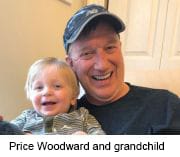THURSDAY, Nov. 1, 2018 (HealthDay News) — Price Woodward was the picture of health at age 52. He lived an active lifestyle and ran marathons. He was definitely not the type of person you’d expect to have a stroke.
But one night, his wife, Tammy, heard a strange noise coming from the other side of the bed. She turned on the light and Price started talking to her, but she couldn’t understand what he was saying.
Tammy could tell something wasn’t right, so she called 911. But because Price had the stroke in his sleep and his wife had no way of knowing exactly when the stroke began, he wasn’t eligible for clot-busting medication that can sometimes stop a stroke before much damage is done.
“His stroke was really bad. It affected the left side of his body, and he couldn’t even sit up. If I hadn’t been home, I think he would’ve died. It’s been a long road to recovery,” Tammy said.
But Price, who lives in Greensboro, Ga., had a lot of motivation to go through stroke rehabilitation to get better. His middle daughter got engaged after he’d had the stroke, and he was determined to be there for her wedding day.
“I told my therapist I was going to walk her down the aisle,” he said.
Stroke therapy is very specific, tailored rehab. Tammy explained that even though Price started rehabilitation in a wheelchair, his therapist helped him achieve the goal of walking. She calculated how many steps it would be, how his gait might affect his balance, and even considered how the train of the dress would play into his walking down the aisle.
Lots of hard work paid off. Not only did Price escort his middle daughter down the aisle, he was also able to attend his youngest daughter’s graduation and welcome his oldest daughter’s first child.
But as far as he’s come in recovery, Price knows that if he could have gotten help faster, things might have been very different.
A friend of his also had a stroke, but it happened in front of the friend’s family. His friend was able to get to the hospital right away and received the clot-buster drug called TPA. His friend was essentially back to normal in four months, Price said.
In comparison, Price is still recovering from his stroke four years later.
“If you see someone having a stroke, make a note of what time it is,” he advised, because doctors will want to know what time the symptoms began.
Dr. Olajide Williams, director of acute stroke services at New York-Presbyterian Hospital, agreed that acting quickly can save lives. An easy way to remember what to look out for is the acronym FAST:
- F is for face. If one half of the face droops when you ask someone to smile or show their teeth, that person may be having a stroke.
- A is for arm. Ask the person to raise both arms. If someone is having a stroke, one arm won’t go up at all or may not go up as much and then goes down quickly.
- S is for speech. Talking gibberish or slurring words might be a sign of a stroke.
- T is for time to call 911. “Time is brain. Every minute that a stroke is allowed to continue, you lose 2 million brain cells. The more brain cells that die, the less the chance is for reversing the stroke with treatment,” Williams said.
There’s usually a three-hour window from the time stroke symptoms begin until you can receive treatment with TPA, or in certain cases, 4.5 hours. With endovascular (blood vessel) treatments, you have six hours from the first symptoms, Williams said.
Don’t try to drive yourself to the hospital, he said. “The call to 911 is critical. It bypasses any waiting. The ambulance notifies the hospital and that activates the hospital system and stroke team,” he added.
Williams also cautioned not to think you’re immune from stroke if you’re younger. He said strokes are occurring in younger people, especially in communities with more obesity and diabetes.
Like Price, Williams wants people to know there is life after stroke. “Even if an individual doesn’t receive acute treatment, rehabilitation can improve function and accelerate recovery,” Williams said.
More than 7 million Americans aged 20 and older have had a stroke, according to the American Stroke Association.
More information
Learn more about FAST and spotting a stroke from the American Stroke Association.
Copyright © 2025 HealthDay. All rights reserved.

